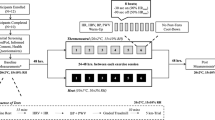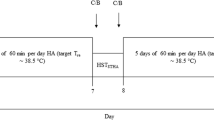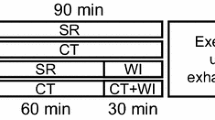Abstract
The aim of this study was to examine the influence of aerobic fitness and exercise intensity on the development of thermal and cardiovascular strain in uncompensable heat stress conditions. In three separate trials, eight aerobically trained and eight untrained subjects cycled to exhaustion at 60% (H60%) and 75% (H75%) of maximal oxygen uptake \( \left( {\dot{V}{\text{O}}_{{ 2 {\text{max}}}} } \right) \) in 40°C conditions, and for 60 min at 60% \( \dot{V}{\text{O}}_{{ 2 {\text{max}}}} \) in 18°C conditions (CON). Training status had no influence on time to exhaustion between trained (61 ± 10 and 31 ± 9 min) and untrained (58 ± 12 and 26 ± 10 min) subjects (H60% and H75%, respectively). Rectal temperature at exhaustion was also not significantly different between trained (39.8 ± 0.3, 39.3 ± 0.6 and 38.2 ± 0.3°C) and untrained (39.4 ± 0.5, 38.8 ± 0.5 and 38.2 ± 0.4°C) subjects, but was different between trials (H60%, H75% and CON, respectively; P < 0.01). However, because exercise was terminated on reaching the ethics approved rectal temperature limit in four trained subjects in the H60% trial and two in the H75% trial, it is speculated that increased rectal temperature may have further occurred in this cohort. Nonetheless, exhaustion occurred >96% of maximum heart rate in both cohorts and was accompanied by significant declines in stroke volume (15–26%), cardiac output (5–10%) and mean arterial pressure (9–13%) (P < 0.05). The increase in cardiovascular strain appears to represent the foremost factor precipitating fatigue during moderate and high intensity aerobic exercise in the heat in both trained and untrained subjects.




Similar content being viewed by others
References
Allan JR (1965) The effects of physical training in a temperate and hot climate on the physiological responses to heat stress. Ergonomics 8:445–453
Armstrong LE, Pandolf KB (1988) Physical training, cardiorespiratory physical fitness and exercise-heat tolerance. In: Pandolf KB, Gonzalez RR, Sawka MN (eds) Human performance physiology and environmental medicine at terrestrial extremes. Benchmark, Indianapolis, IN, pp 199–226
Arngrimsson SA, Stewart DJ, Borrani F, Skinner KA, Cureton KJ (2003) Relation of heart rate to percent VO2peak during submaximal exercise in the heat. J Appl Physiol 94:1162–1168
Asmussen E (1940) The cardiac output in rest and work in humid heat. Am J Physiol 131:54–59
Baker LB, Lang JA, Kenney LW (2009) Change in body mass accurately and reliably predicts change in body water after endurance exercise. Eur J Appl Physiol 105:959–967
Bedford T (1936) The warmth factor in comfort at work: a physiological study of heating and ventilation. Industrial Health Research Board Report No. 76
Borg GA (1982) Psychophysical bases of perceived exertion. Med Sci Sports Exerc 14:377–381
Brengelmann GL (1983) Circulatory adjustments to exercise and heat stress. Annu Rev Physiol 45:191–212
Brengelmann GL, Johnson JM, Hermansen L, Rowell LB (1977) Altered control of skin blood flow during exercise at high internal temperatures. J Appl Physiol 43:790–794
Byrne C, Lee JKW, Chew SAN, Lim CL, Tan EYM (2006) Continuous thermoregulatory responses to mass-participation distance running in heat. Med Sci Sports Exerc 38:803–810
Cheung SS, McLellan TM (1998) Heat acclimation, aerobic fitness, and hydration effects on tolerance during uncompensable heat stress. J Appl Physiol 84:1731–1739
Cheung SS, McLellan TM, Tenaglia S (2000) The thermophysiology of uncompensable heat stress. Sports Med 29:329–359
Cheung SS, Sleivert GG (2004) Multiple triggers for hyperthermic fatigue and exhaustion. Exerc Sport Sci Rev 32:100–106
Cheuvront SN, Kenefick RW, Montain SJ, Sawka MN (2010) Mechanisms of aerobic performance impairment with heat stress and dehydration. J Appl Physiol 109:1989–1995
Cheuvront SN, Montain SJ, Sawka MN (2007) Fluid replacement and performance during the marathon. Sports Med 37:353–357
Collier CR (1956) Determination of mixed venous CO2 tensions by rebreathing. J Appl Physiol 9:25–29
Crandall CG, González-Alonso J (2010) Cardiovascular function in the heat stressed human. Acta Physiol 199:407–423
Ekblom B (1969) The oxygen transport system in athletes. Acta Physiol Scand 77:17–20
Ely BR, Cheuvront SN, Kenefick RW, Sawka MN (2010) Aerobic performance is degraded, despite modest hyperthermia, in hot environments. Med Sci Sports Exerc 42:135–141
Ely BR, Ely MR, Cheuvront SN, Kenefick RW, DeGroot DW, Montain SJ (2009) Evidence against a 40°C core temperature threshold for fatigue in humans. J Appl Physiol 107:1519–1525
Givoni B, Goldman RF (1972) Predicting rectal temperature response to work, environment, and clothing. J Appl Physiol 32:812–822
González-Alonso J, Calbet AL (2003) Reductions in systemic and skeletal muscle blood flow and oxygen delivery limit maximal aerobic capacity in humans. Circulation 107:824–830
González-Alonso J, Dalsgaard MK, Osada T, Volianitis S, Dawson EA, Yoshiga CC, Secher NH (2004) Brain and central haemodynamics and oxygenation during maximal exercise in humans. J Physiol 557:331–342
González-Alonso J, Teller C, Andersen SL, Jensen FB, Hyldic T, Nielsen B (1999) Influence of body temperature on the development of fatigue during prolonged exercise in the heat. J Appl Physiol 86:1032–1039
Harrisson MH (1985) Effects on thermal stress and exercise on blood volume in humans. Physiol Rev 65:149–209
Johnson JM (1977) Regulation of skin circulation during prolonged exercise. Ann NY Acad Sci 301:195–212
Johnson JM (1986) Nonthermoregulatory control of human skin blood flow. J Appl Physiol 61:1613–1622
Johnson JM (1992) Exercise and the cutaneous circulation. Exerc Sport Sci Rev 20:59–97
Johnson JM, Park MK (1979) Reflex control of skin blood flow by skin temperature: role of core temperature. J Appl Physiol 47:1188–1193
Johnson JM, Rowell LB (1975) Forearm skin and muscle vascular responses to prolonged leg exercise in man. J Appl Physiol 39:920–924
Kenefick RW, Cheuvront SN, Palombo LJ, Ely BR, Sawka MN (2010) Skin temperature modifies the impact of hypohydration on aerobic performance. J Appl Physiol 109:79–86
Kenefick RW, Ely BR, Cheuvront SN, Palombo LJ, Goodman DA, Sawka MN (2009) Prior heat stress: effect on subsequent 15-min time trial performance in the heat. Med Sci Sports Exerc 41:1311–1316
Kraning KK, Gonzalez RR (1991) Physiological consequences of intermittent exercise during compensable and uncompensable heat stress. J Appl Physiol 71:2138–2145
Lee J, Nio A, Lim C, Teo E, Byrne C (2010) Thermoregulation, pacing and fluid balance during mass participation distance running in a warm and humid environment. Eur J Appl Physiol 109:887–898
Mitchell JW, Nadel ER, Stolwijk JA (1972) Respiratory weight losses during exercise. J Appl Physiol 32:474–476
Montain SJ, Sawka MN, Cadarette BS, Quigley MD, McKay JM (1994) Physiological tolerance to uncompensable heat stress: effects of exercise intensity, protective clothing, and climate. J Appl Physiol 77:216–222
Mora-Rodriguez R, Coso J, Hamouti N, Estevez E, Ortega J (2010) Aerobically trained individuals have greater increases in rectal temperature than untrained ones during exercise in the heat at similar relative intensities. Eur J Appl Physiol 109:973–981
Mortensen SP, Damsgaard R, Dawson EA, Secher NH, González-Alonso J (2008) Restrictions in systemic and locomotor skeletal muscle perfusion, oxygen supply and VO2 during high-intensity whole-body exercise in humans. J Physiol 586:2621–2635
Mortensen SP, Dawson EA, Yoshiga CC, Dalsgaard MK, Damsgaard R, Secher NH, Gonzalez-Alonso J (2005) Limitations to systemic and locomotor limb muscle oxygen delivery and uptake during maximal exercise in humans. J Physiol 566:273–285
Nadel ER, Cafarelli E, Roberts MF, Wenger CB (1979) Circulatory regulation during exercise in different ambient temperatures. J Appl Physiol 46:430–437
Nielsen B, Hales JRS, Strange S, Christensen NJ, Warberg J, Saltin B (1993) Human circulatory and thermoregulatory adaptations with heat acclimation and exercise in a hot, dry environment. J Physiol 460:467–485
Nielsen B, Hyldig T, Bidstrup F, González-Alonso J, Christoffersen GR (2001) Brain activity and fatigue during prolonged exercise in the heat. Pflugers Arch—Eur J Physiol 442:41–48
Nunneley SA, Antuñano MJ, Bomalaski SH (1992) Thermal convergence fails to predict heat tolerance limits. Aviat Space Environ Med 63:886–890
Nybo L (2008) Hyperthermia and fatigue. J Appl Physiol 140:871–878
Nybo L, Jensen T, Nielsen B, Gonzalez-Alonso J (2001) Effects of marked hyperthermia with and without dehydration on VO2 kinetics during intense exercise. J Appl Physiol 90:1057–1064
Nybo L, Nielsen B (2001a) Hyperthermia and central fatigue during prolonged exercise in humans. J Appl Physiol 91:1055–1060
Nybo L, Nielsen B (2001b) Perceived exertion is associated with an altered brain activity during exercise with progressive hyperthermia. J Appl Physiol 91:2017–2023
Nybo L, Secher NH, Nielsen B (2002) Inadequate heat release from the human brain during prolonged exercise with hyperthermia. J Physiol 575:697–704
Pandolf KB, Goldman RF (1978) Convergence of skin and rectal temperatures as a criterion for heat tolerance. Aviat Space Environ Med 49:1095–1101
Parsons KC (2003) Human thermal environments: the effet of hot, moderate and cold environments on human health, comfort and performance. Taylor & Francis, New York
Périard JD, Caillaud C, Thompson MW (2011) Central and peripheral fatigue during passive and exercise-induced hyperthermia. Med Sci Sports Exerc 43:1657–1665
Pugh LGCE, Corbett JL, Johnson RH (1967) Rectal temperatures, weight losses, and sweat rates in marathon running. J Appl Physiol 23:347–352
Ramanathan NL (1964) A new weighting system for mean surface temperature of the human body. J Appl Physiol 19:531–533
Rasmussen P, Nybo L, Volianitis S, Møller K, Secher NH, Gjedde A (2010) Cerebral oxygenation is reduced during hyperthermic exercise in humans. Acta Physiol 199:63–70
Robinson S, Turrell ES, Gerking SD (1945) Physiological equivalent conditions of air temperature and humidity. Am J Physiol 143:21–32
Rowell LB (1974) Human cardiovascular adjustments to exercise and thermal stress. Physiol Rev 54:75–159
Rowell LB (1977) Competition between skin and muscle for blood flow during exercise. In: Nadel ER (ed) Problems with temperature regulation during exercise. Academic Press, New York, pp 49–76
Rowell LB (1986) Human circulation: regulation during physical stress. Oxford University Press, New York
Rowell LB, Marx HJ, Bruce RA, Conn RD, Kusumi F (1966) Reductions in cardiac output, central blood volume, and stroke volume with thermal stress in normal men during exercise. J Clin Invest 45:1801–1816
Rowell LB, Murray JA, Brengelmann GL, Kranning KK (1969) Human cardiovascular adjustments to rapid changes in skin temperature during exercise. Circ Res 24:711–724
Sahlin K, Henriksson J (1984) Buffer capacity and lactate accumulation in skeletal muscle of trained and untrained men. Acta Physiol Scand 122:331–339
Sawka MN, Burke LM, Eichner ER, Maughan RJ, Montain SJ, Stachenfeld NS (2007) American College of Sports Medicine position stand: exercise and fluid replacement. Med Sci Sports Exerc 39:377–390
Sawka MN, Latzka WA, Montain S, Cadarette BS, Kolka MA, Kraning KK II, Gonzalez RR (2001) Physiologic tolerance to uncompensable heat: intermittent exercise, field versus laboratory. Med Sci Sports Exerc 33:422–430
Sawka MN, Young AJ, Latzka WA, Neufer PD, Quigley MD, Pandolf KB (1992) Human tolerance to heat strain during exercise: influence of hydration. J Appl Physiol 73:368–375
Selkirk GA, McLellan TM (2001) Influence of aerobic fitness and body fatness on tolerance to uncompensable heat stress. J Appl Physiol 91:2055–2063
Selkirk GA, McLellan TM, Wright HE, Rhind SG (2008) Mild endotoxemia, NF-κB translocation, and cytokine increase during exertional heat stress in trained and untrained individuals. Am J Physiol Regul Integr Comp Physiol 295:R611–R623
Senay LC, Mitchell D, Wyndham CH (1976) Acclimatization in a hot, humid environment: body fluid adjustments. J Appl Physiol 40:786–796
van Marken Lichtenbelt WD, Daanen HA, Wouters L, Fronczek R, Raymann RJ, Severens NM, Van Someren EJ (2006) Evaluation of wireless determination of skin temperature using iButtons. Physiol Behav 88:489–497
Williams CG, Bredell GAG, Wyndham CH, Strydom NB, Morrison JF, Peter J, Fleming PW, Ward JS (1962) Circulatory and metabolic reactions to work in heat. J Appl Physiol 17:625–638
Acknowledgment
The authors thank all the subjects that participated in this investigation, as well as Rhys Philips, Madeline Lynch, Colin Tuohy, Carl Cheah, Angelina Tan, and Thomas Wüthrich for their help with data collection. This work was supported by the University of Sydney Faculty of Health Sciences.
Conflict of interest
The authors declare that they have no conflict of interest.
Author information
Authors and Affiliations
Corresponding author
Additional information
Communicated by Nigel A.S. Taylor.
Rights and permissions
About this article
Cite this article
Périard, J.D., Caillaud, C. & Thompson, M.W. The role of aerobic fitness and exercise intensity on endurance performance in uncompensable heat stress conditions. Eur J Appl Physiol 112, 1989–1999 (2012). https://doi.org/10.1007/s00421-011-2165-z
Received:
Accepted:
Published:
Issue Date:
DOI: https://doi.org/10.1007/s00421-011-2165-z




